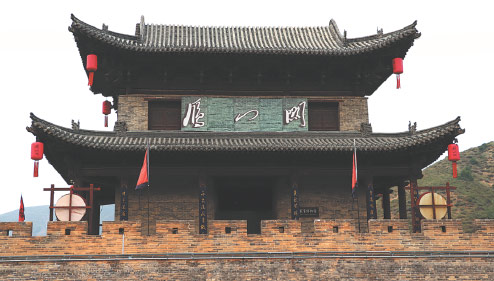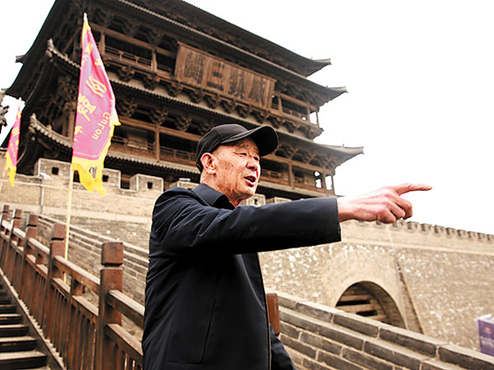Honoring the past

A view of Yanlou, a structure from the Ming Dynasty (1368-1644), on the Yanmen Pass, featuring a double-eaved gable-and-hip roof and surrounded by a winding corridor. [Photo provided to China Daily]
Family influence has laid solid foundations for Yang Guiting's career, and even helped him build it. Restoring ancient buildings, not just the brickwork or the window frames and lintels, but bringing back their sense of presence, of purpose, has been Yang's calling.
Yang, in his 70s, has played a key role in restoring the charm and glory of historical buildings in Daixian county, Xinzhou city, Shanxi province.
The county, which is home to more than 400 examples of immovable cultural heritage, was recognized as a national-level historical and cultural location by the State Council in 1994.
Daixian lies at the foot of the Yanmen Pass of the Great Wall, long known for its precarious geological conditions.
"The county was a place of strategic importance and has seen major construction projects since the Song Dynasty (960-1279)," says Li Peigen, a local culture scholar in Daixian.
For more than 1,000 years, mass military defense systems, ancient government officials' mansions, temples and distinctive folk houses have, at various points, been erected in the county, Li says.
It has thus nurtured a multitude of skilled craftsmen, especially carpenters and plasterers, who have dedicated themselves to the development and maintenance of those major projects.
Yang was born in 1948 into one of the most prominent carpentry families-with a history stretching back 40 generations in the trade. His family has left its mark on ancient architecture, from the prairies of the Inner Mongolia autonomous region to coastal cities in the east of the country.
At the age of 16, he accompanied his father around the county, rising with the lark and building houses for locals. From the basic use of a saw and an adze (similar to an axe), to the drawing of a floor plan with a ruler, Yang quickly acquired a solid grasp of his father's expertise and the features of those ancient buildings.

Yanlou in the late 1980s, after its first renovation by veteran restorer Yang Guiting and his team. [Photo provided to China Daily]
At 23, he was employed by a major steel company in the provincial capital Taiyuan on the strength of his craftsmanship. "It was an envious position, to be an employee, back then," Yang recalls.
However, six months later, he quit and returned to Daixian. "I couldn't let go of the carpentry skills my father taught me," he explains.
It was then that Yang embarked on his journey of restoring historical buildings.
He first attempted the restoration of several abandoned local temples at the request of the local authority and, in 1983, went on to establish a team of masons, bricklayers and carpenters.
By 1988, their experience and growing reputation resulted in them being given the opportunity of restoring Yanlou, a structure from the Ming Dynasty (1368-1644), on the Yanmen Pass, when the Xinzhou cultural relic bureau offered funding of 160,000 yuan ($25,231) for the project. Yanlou features a double-eaved gable-and-hip roof and is surrounded by a winding corridor.
Restoring it required a large amount of building materials, including 400 cubic meters of wood.
The old routes to the Yanmen Pass were inaccessible at that time, with the only route being a narrow sheep track. "It didn't permit vehicles to pass, and we had to rely on donkeys and horses to deliver the necessary materials," Yang recalls.
"For some big logs, we had more than 50 people carry them by hand-you can only imagine the complexity of the project," he adds.
When everything was in place, Yang led his team in restoring the site piece by piece. It took them three years to finish the project, enduring harsh conditions, during which Yang lost part of three of his fingers.
"They were accidentally cut by an electric planer. They serve as a good reminder of the experience," he says.

Yang in front of Bianjing Drum Tower, another building he and his team restored, in Daixian county, Shanxi province. [Photo provided to China Daily]
Moreover, Yang also had to cover an extra 20,000 yuan in costs on top of the government funding, due to the complexity of the project.
"But it was all worth it," he says. "I completed a significant job, which was very close to my heart."
Yang's contribution and the feat of his team was brought to wider attention, especially when Yanmen Pass was named a major national cultural unit under protection by the State Council in 2001.
In October 1998, the Shanxi provincial cultural relic bureau arranged for Yang to take charge of repairing Bianjing Drum Tower, also known as the Bianjing Pavilion. It was constructed during the Ming Dynasty for military observation and signaling by means of drums.
Although the building underwent repairs during the Qing Dynasty (1644-1911), by the late 1990s, it was in a dire need of restoration. "Grass and even small trees were growing underfoot," Yang recalls.
It took three years for more than 50 workers to finish the project, he adds. They used their bodies and hands, as well as pulleys and ropes to yank huge pillars up to the building site.
Ji Liangsheng, a senior official from Daixian culture and tourism bureau, says that there were cranes available, but due to a tight budget, they had to resort to old-fashioned manual force.
When Yang found previous repairs had involved construction waste being used to fill and shore up the sinking foundations, he immediately decided to replace it with the standard mixture of lime, sand and clay.
"The costs were not in the budget and Yang had to dig into his own pocket," Ji recalls.
It was this spirit of craftsmanship that has fortified the Bianjing Drum Tower, Ji adds.
To best preserve certain parts of the ancient building, Yang insisted on mending a major structural beam that stabilized the whole construction, which had warped and cracked. "The ancient parts are all priceless, and won't be replaced as long as they can be used to some degree," he explains.

Yanmen Pass of the Great Wall located in Shanxi province, now a top-rated scenic spot. [Photo provided to China Daily]
Yang and his team ended up installing a steel girder to consolidate and straighten the beam.
He says he can still remember the dust that had accumulated on the beam over hundreds of years and how they had to blast it away when it was taken down for repair.
With surgical precision, Yang has given the drum tower a new lease of life.
"Bianjing Drum Tower is the work I'm most proud of," Yang says.
The project put Yang on the restoration map. His team has been invited to work on major historical structures at national, provincial and municipal levels.
Yang's two sons have also inherited the family tradition and followed in his footsteps.
In 2009, Yang and his sons led a team of workers back to the Yanmen Pass and worked on 1,800 meters of the Great Wall, upon which they also restored watchtowers and gate towers, as well as historical temples and a nearby folk village.
They finished the task in 2011, the same year the State Council listed "Yanmen folk house construction techniques" as a national intangible culture heritage.
Thanks to Yang's efforts, the Yanmen Pass scenic spot is one of the best culture and tourism destinations in the country and was classified as a top-rated national scenic spot in 2017.
Yang has shifted his focus to ancient architecture protection and inheritance, and has made a point of sharing his skills with more people beyond his family.
"As long as they want to learn, I'll hold nothing back," Yang says.
Half of the artisans in Daixian have been Yang's apprentices.
However, Yang has noticed a decreasing number of young people in his team.
"Most of them prefer modern trades," Yang says, adding that he hopes further support will be given to carry forward Yanmen house construction techniques.
Ji says he believes Yang's prayer will surely be answered.
The intangible culture heritage can be applied to a wide range of fields and help build the culture industry, which, in turn, will boost heritage development, Ji says. "The government will offer more support for its protection and utilization."
Peng Ke'er contributed to the story.



